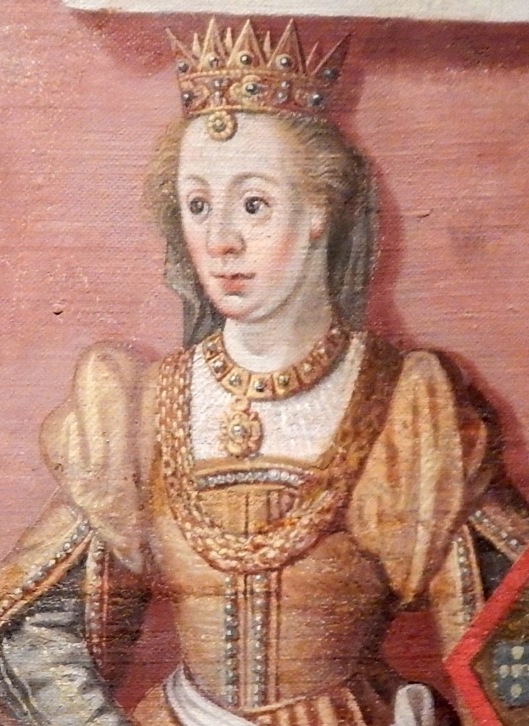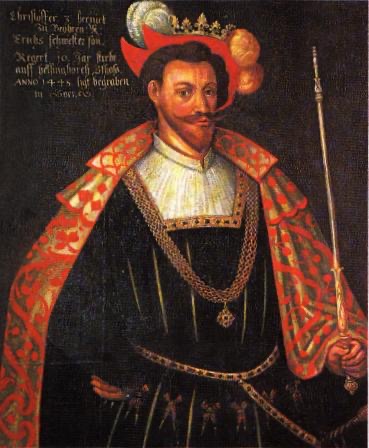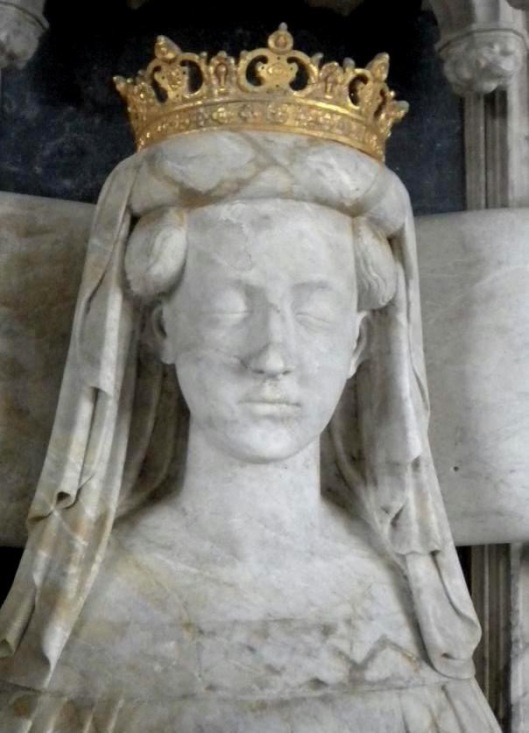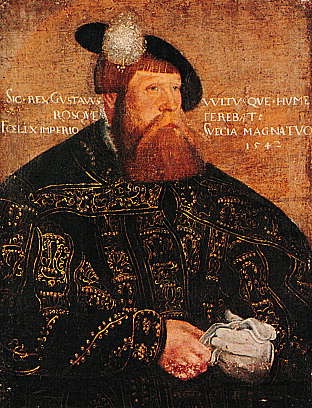Tags
Eric of Pomerania, Henry Bolingbroke, Henry IV of England, Kingdom of Denmark, Kingdom of England, Kingdom of Norway, Kingdom of Sweden, Mary de Bohun, Philippa of England, Queen Margrethe I of Denmark, Regent, Scandinavia, Union of Kalmar
Philippa of England (June 4, 1394 – January 5, 1430), also known as Philippa of Lancaster, was Queen of Denmark, Norway and Sweden from 1406 to 1430 by marriage to King Eric of Pomerania during the Kalmar Union. She was the daughter of King Henry IV of England by his first spouse Mary de Bohun and the younger sister of King Henry V. Queen Philippa participated significantly in state affairs during the reign of her spouse, and served as regent of Denmark from 1423 to 1425.

Philippa of England
Family and Early life
Philippa was born to Henry Bolingbroke and Mary de Bohun, at Peterborough Castle, Peterborough. Her father became king in 1399. She is mentioned a couple of times during her childhood: in 1403, she was present at her widowed father’s wedding to Joan of Navarre, and the same year, she made a pilgrimage to Canterbury. She mainly lived at Berkhamsted Castle and Windsor Castle.
Henry IV’s first wife Mary de Bohun died at Peterborough Castle, giving birth to her last child Philippa of England. She was buried in the collegiate Church of the Annunciation of Our Lady of the Newarke, Leicester on July 6, 1394.

Henry IV, King of England and Lord of Ireland
Through Mary de Bohun was also a descendant of the Kings of England. Mary was a daughter of Humphrey de Bohun, 7th Earl of Hereford (1341-1373) by his wife Joan FitzAlan (1347/8–1419), a daughter of Richard FitzAlan, 10th Earl of Arundel and Eleanor of Lancaster. Through her mother, Mary was descended from Llywelyn the Great.
Mary’s grandmother (Philippe’s great-grandmother) Eleanor of Lancaster, Countess of Arundel (sometimes called Eleanor Plantagenet; 1318-1372) was the fifth daughter of Henry, 3rd Earl of Leicester and Lancaster and Maud Chaworth. Henry, 3rd Earl of Leicester and Lancaster (c. 1281 – 22 September 1345) was a grandson of King Henry III (1216–1272) of England and was one of the principals behind the deposition of King Edward II (1307–1327), his first cousin.
Marriage
In 1400 or 1401, King Henry IV suggested to Queen Margarethe I of Denmark, Norway and Sweden that an alliance be formed between England and the Kalmar Union through a double wedding between Henry’s daughter Philippa to the heir to the Nordic thrones, Eric of Pomerania, and Henry’s son Henry to Eric’s sister Catherine.
Eric of Pomerania (1381 or 1382 – September 24, 1459) was the ruler of the Scandinavian Kalmar Union from 1396 until 1439, succeeding his grandaunt, Queen Margarethe I. He is numbered Eric III as King of Norway (1389–1442), Eric VII as King of Denmark (1396–1439) and Eric XIII as King of Sweden (1396–1434, 1436–39). Later, in all three countries he became more commonly known as Eric of Pomerania.

Eric of Pomerania, King of Denmark, Norway and Sweden.
Queen Margarethe could not agree to the terms and the marriage between Henry and Catherine never occurred. In 1405, however, a Scandinavian embassy composed of two envoys from each of the three Nordic kingdoms arrived in England, and the marriage between Philippa and Eric was proclaimed.
The November 26, 1405, Philippa was married to Eric by proxy in Westminster, with the Swedish nobleman Ture Bengtsson Bielke as the stand-in for the groom, and on December 8, she was formally proclaimed Queen of Denmark, Norway and Sweden in the presence of the Nordic ambassadors.
Philippa left England from Lynn in August 1406 with an entourage of male and female English nobles and arrived in Helsingborg in September, where she was greeted by Eric and Queen Margaret. The wedding between Philippa and Eric of Pomerania took place on October 26, 1406 in Lund Cathedral.
Philippa was the first documented princess in history to wear a white wedding dress during a royal wedding ceremony: she wore a tunic with a cloak in white silk bordered with grey squirrel and ermine. The wedding ceremony was followed by her coronation.
The festivities lasted until November, during which several men were knighted and Philippa’s dowry was officially received by the court chamberlain and clerics from the three kingdoms. Philippa was in turn granted dower lands in all three kingdoms: Närke and Örebro In Sweden, Fyn with Odense and Nasbyhoved in Danmark, and Romerike in Norway.
Queen and Regent
Queen Philippa and King Eric lived in Kalmar Castle in Sweden with their court the first three years of their marriage. Philippa was given her own court, supervised by her chief lady in waiting, Lady Katarina Knutsdotter, a granddaughter of Saint Bridget of Sweden through Lady Märta Ulfsdotter, who had been the chief lady in waiting of Queen Margarethe herself.
From 1409 onward, and particularly after the death of Queen Margarethe I in 1412, when Eric became King de facto, the royal couple mainly resided in Denmark. However, Philippa frequently returned to Sweden, and as she had lived there during her first years in Scandinavia, she was given a close relationship to Sweden, of the three Kingdoms, from the beginning.
Queen Philippa was actively involved in state affairs. By the Pomeranian Act of Succession of 1416, Eric named his cousin Bogusław IX of Pomerania as heir to the three Kingdoms if his marriage to Philippa remained childless. When Eric left to participate in warfare in Femern in 1420, the Act was amended and Philippa was given an active role. The revised Act stated that upon the death of Eric, Queen Philippa should be appointed Regent of the realm until Bogusław could be instated as King; and should Bogusław inherit the three Kingdoms while still a minor, Philippa would serve as Regent during his minority.
Eric evidently had great trust in Philippa. Both ancient and modern authors give a favourable account of her rule. It is said that in certain matters she was more efficient than Eric. However, scholars have largely accepted this judgment of the Queen without going into detail. Her great dower lands in Sweden increased Philippa’s interest in this Kingdom, and while Eric preferred to reside in Denmark, Philippa made such frequent and long visits in Sweden, where she acted as Eric’s proxy while present, that she was the de facto Regent of Sweden for the most part of the 1420s, though not formally made such.
In the spring of 1426, Philippa was sent to Sweden by Eric where she summoned the Swedish council in Vadstena and managed to secure support and funds for the Dano-Hanseatic War (1426–35) despite the Swedish opposition to this war. In January 1427, when the war was going the wrong way for Eric, she summoned the Swedish council to Nyköping, where she again managed to secure Swedish support for Eric in his war. At this visit, she also acquired additional Swedish estates to support her future in Sweden, where she evidently planned to retire as a widow.
In March 1427 she returned to Denmark where she stayed for three years during the war. In 1428, Philippa successfully organized the defense of the Danish capital against the attack of the Hanseatic League during the 1428 bombardment of Copenhagen. She was hailed as a heroine by the people of Copenhagen for rallying the citizens to fight the Hanseatic fleet in Copenhagen Harbor.
In late 1429, Philippa left for Sweden, officially on a mission from Eric to secure support for his war in Sweden, where the war had been opposed from the start. In Sweden, she traveled to Vadstena Abbey as usual, where she was welcomed by a delegation of Swedish riksråd. Not long after her arrival, however, she fell ill.
This was an attack of some kind of a recurring illness which had been noted to affect her at times for at least the previous five years. The queen bore a stillborn boy and her health deteriorated after the stillbirth. She died on January 5, 1430 at the age of 35 and was buried in the Cloister Church at Vadstena, close to Linköping in Östergötland, Sweden. She made several donations to Vadstena Abbey in her will. After her death Eric formed a relationship with a former lady-in-waiting of Philippa’s, Cecilia.











